6.03.2020
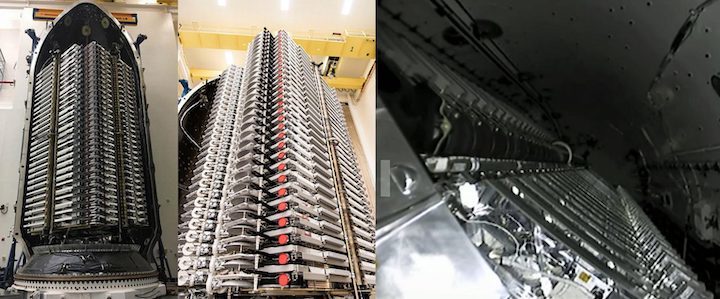
CEO Elon Musk says SpaceX is churning out Starlink satellites faster than it can launch them, the best sign yet that the company is having some amazing success in what is already the most productive satellite factory in history.
Since SpaceX first revealed its radical flat-satellite Starlink design, stacking approach, and deployment mechanism back in May 2019, the company has successfully launched an incredible 300 satellites, ~290 of which are still functioning as intended. At this point, that means that Starlink is likely the largest satellite constellation in history by a factor of two, crushing the second largest’s ~150 satellites. Perhaps even more significant is the mass of SpaceX’s nine-month-old constellation, currently standing at more than 75 metric tons (165,000 lb) of satellites in orbit.
Despite the already awe-inspiring scale of SpaceX’s satellite internet constellation, the company’s Starlink factory is already so successful that the company is now unable to launch the spacecraft as quickly as they’re built. Given that SpaceX has maintained an average of ~1.3 Starlink launches per month since November 2019, many of which suffered significant delays as a result of weather or minor hardware issues, this likely means that SpaceX is building dozens more satellites than it can launch, probably creating its own internal launch manifest backlog as those surplus spacecraft pile up.
Considering the fact that SpaceX has gone from two prototype spacecraft to the proud owner of the largest satellite constellation in history in less than nine months, the fact that the company’s Starlink factory is already outpacing its launch capacity is arguably a good sign. While it’s likely that weather and hardware-related launch delays on the last few Starlink missions have made it harder than expected to stick to plans for an average of two Starlink launches per month, SpaceX isn’t falling that short of its classically lofty ambitions (a bit less than one Starlink launch every two weeks).
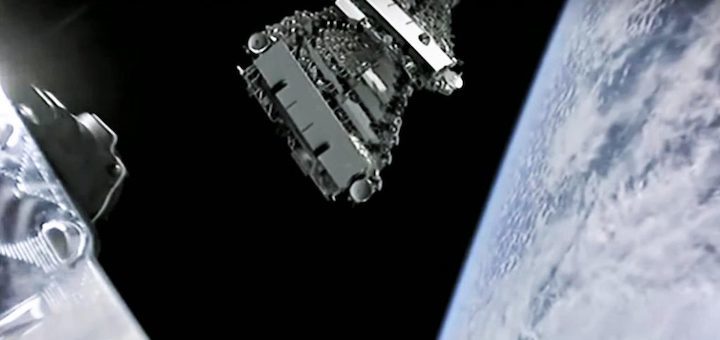
SpaceX may now be the first company in history to chronically suffer from its factories building moresatellites than it can launch in a given time frame. In those terms, a surplus of flight-ready satellites is actually a highly desirable “problem” to have. Competitor OneWeb, for example, was forced to delay its first 34-satellite launch by two months after its new Florida factory suffered several production delays.
SpaceX, on the other hand, has to build almost twice as many satellites per launch, has effectively launched 35% of OneWeb’s entire constellation (~650 satellites) in the last three months alone, and still has an apparent backlog of satellites ready to head to orbit. As of March 3rd, SpaceX’s fifth launch of 60 upgraded Starlink v1.0 satellites and sixth launch overall (Starlink V1 L5 or Starlink-6) is scheduled to lift off no earlier than March 14th after slipping from February 14th, March 4th, and March 11th. The mission’s most recent delays were caused by an issue discovered in the Falcon 9 second stage assigned to launch Cargo Dragon’s CRS-20 mission, triggering SpaceX to swap it with Starlink V1 L5’s unaffected second stage.
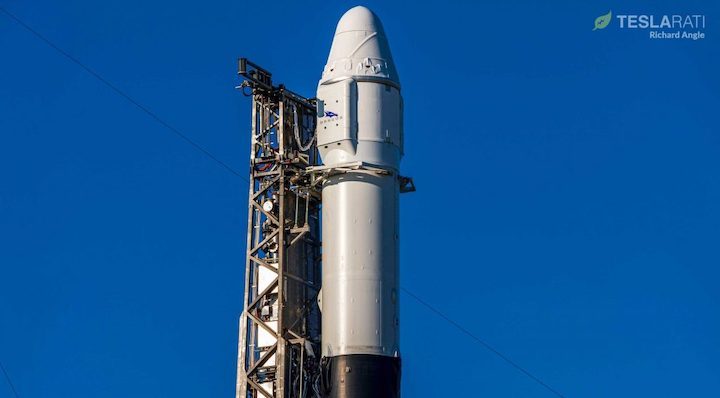
After Starlink V1 L5, SpaceX has more batches of 60 Starlink satellites that – given Musk’s comments – might already be stacked and ready for flight, both of which could potentially fly in March or April. In the midst of its Starlink launch ambitions, SpaceX has scheduled Florida’s first polar launch in half a century on March 30th, followed by a historic US Air Force launch and landing no earlier than (NET) April 27th.
If Cargo Dragon successfully lifts off this Friday, SpaceX will reach an average of ~1.9 weeks per launch, a cadence that – if maintained – would set the company up for at least 27 launches in 2020. With room for improvement after several weather-related days: so far, so good.
Quelle: TESLARATI
----
Update: 10.03.2020
.
Musk: we’re not spinning off Starlink

WASHINGTON — SpaceX has no plans to make Starlink a separate business, Elon Musk, SpaceX’s founder and chief executive, said March 9.
Musk, speaking at the Satellite 2020 conference here, said SpaceX is “thinking about that zero,” instead focusing mainly on ensuring Starlink doesn’t flop.
The precedent set by past companies that attempted big telecom constellations in low Earth orbit and went bankrupt, either briefly or permanently, is one SpaceX wants to avoid, he said.
“That would be a big step, to have more than zero in the not bankrupt category,” Musk said.
Iridium, Globalstar, Orbcomm and Teledesic all went bankrupt about two decades ago, though only Teledesic failed to recover and deploy a second-generation constellation.
SpaceX President Gwynne Shotwell was quoted in Bloomberg in February saying the company was likely to spinoff Starlink as a public company.
Musk said SpaceX needs Starlink as a revenue generator with more potential than the launch business where SpaceX has established itself with its Falcon 9 and Falcon Heavy rockets. He estimated the broadband connectivity market is worth around $30 billion a year and that the launch sector is around $3 billion annually.
Starlink, a broadband constellation of roughly 300 satellites today but that could eventually number 12,000, or even 42,000, will provide connectivity to people that are unreached or difficult to reach with fiber and cell towers, Musk said.
“Starlink will effectively serve the 3% or 4% hardest to reach customers for telcos, or people who simply have no connectivity right now, or their connectivity is really bad,” Musk said.
SpaceX does not plan to compete with established telecommunications providers, Musk said.
The next 60 Starlink satellites launch March 15, Jonathan Hofeller, vice president of Starlink commercial sales at SpaceX said here. SpaceX is producing six Starlink satellites a day, he said.
Quelle: SN
----
Update: 11.03.2020
.
SpaceX targeting this weekend for Starlink launch from Cape Canaveral
If schedules hold and weather cooperates, the Space Coast's next rocket launch should kick off an idyllic, late winter Florida weekend.
SpaceX teams at Kennedy Space Center's pad 39A are preparing a 230-foot-tall Falcon 9 rocket for a 9:35 a.m. Saturday liftoff, the company's sixth mission with Starlink internet satellites.
A Space Force-issued launch weather forecast, which is strictly for liftoff purposes, is expected Wednesday. For spectators close to the spaceport, the National Weather Service in Melbourne estimates mostly sunny skies, temperatures in the 70s, and light east-northeast winds.
After liftoff, the rocket's 156-foot-tall first stage will target a landing on the company's Of Course I Still Love You drone ship in the Atlantic.
Saturday's flight will mark the company's sixth Starlink mission, pushing the constellation's size to more than 350 in low-Earth orbit. The effort is designed to beam internet connectivity down to the ground from space rather than using complicated on-the-ground infrastructure.
And the push, if successful, should pay dividends. Launch services – just launching rockets and not operating the satellites they fly – total some $6 billion annually, but Starlink could bring in much more – perhaps up to $30 billion, CEO Elon Musk previously said.
Starlink is just one of at least two more flights planned for the rest of the month. A United Launch Alliance Atlas V rocket is scheduled to launch a military communications satellite on the afternoon of March 31, while another Falcon 9 is on the range's calendar for a March 30 liftoff with an Argentinian spacecraft.
Quelle: Florida Today
----
Update: 14.03.2020
.
SpaceX pushes next Starlink launch to Sunday
Liftoff scheduled for 9:22 a.m.
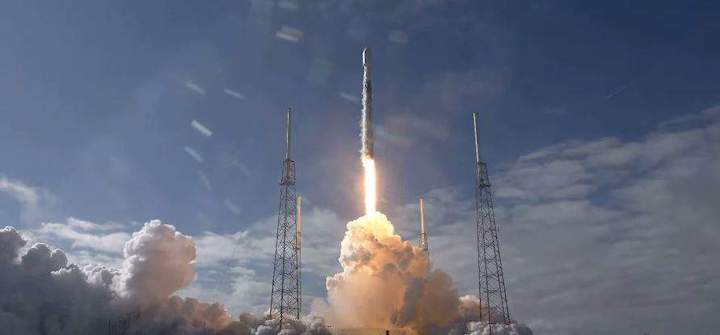
KENNEDY SPACE CENTER – Skip the Sunday morning cartoons and start your day off with a SpaceX launch instead.
The company plans to launch the sixth round of space-based internet satellites from Kennedy Space Center no earlier than Sunday morning. It’s all part of CEO Elon Musk’s plan to begin beaming the internet to people around the globe later this year using a constellation of hundreds of satellites.
Weather is looking good for a Sunday morning launch, according to Air Force weather officials. Liftoff is scheduled for 9:22 a.m. from Kennedy Space Center launchpad 39A.
The launch was originally scheduled for Saturday but was rescheduled for Sunday, according to SpaceX.
Forecasters with the U.S. Air Force 45th Weather Squadron are predicting a 90% chance of good launch conditions for the Falcon 9 liftoff.
SpaceX plans to land the rocket booster on a droneship in the Atlantic Ocean off Florida’s coast about 10 minutes after liftoff.
Weather officers are now forecasting recovery or landing conditions, too. SpaceX typically lands its Falcon boosters on a ship called Of Course I Still Love You in the Atlantic Ocean after liftoff or back at Cape Canaveral on land.
More recently SpaceX launch forecasts include some new factors such as recovery conditions, solar weather and upper-level wind shear. All three of those risks remain low for Saturday, according to the forecast.
SpaceX has launched three rounds of Starlink satellites so far this year in addition to the two Starlink launches last year.
The next launch from the Space Coast is happening March 21 when United Launch Alliance launches an Atlas V rocket with a military communications satellite from Cape Canaveral Air Force Station Launch Complex 41.
Quelle: News6
----
Update: 15.03.2020
.
SpaceX Aims for Sunday Morning Starlink Launch from Florida
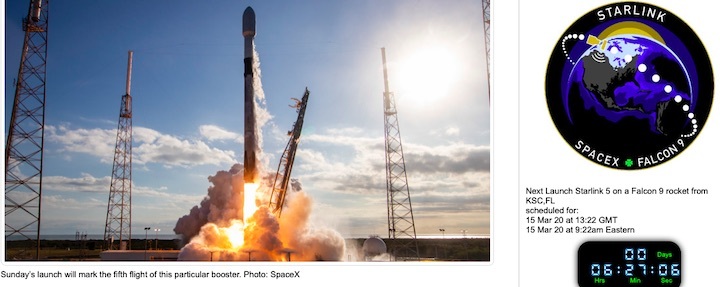
For the first time on Sunday, a five-times-used Falcon 9 booster will spear aloft from historic Pad 39A at the Kennedy Space Center (KSC) in Florida to kick off SpaceX’s sixth overall mission of 2020. Although a handful of boosters have flown four times, none have previously launched a fifth mission.
Laden with another 60 Starlink internet communications satellites—part of CEO Elon Musk’s pledge to emplace thousands of these low-orbiting platforms in space by mid-decade—the mission brings yet another piece of history-making to Pad 39A, which previously supported all but one of the Apollo lunar flights, 82 Space Shuttle launches and which has since 2014 been leased to SpaceX.
Sunday’s liftoff, timed to occur at 9:22 a.m. EDT, will also represent the 20th Falcon to rise from Pad 39A since February 2017, in a run of missions which has also seen the first voyage of the mammoth Falcon Heavy and last year’s maiden flight of Crew Dragon.
All told, this will be Pad 39A’s 113th launch in a little more than five decades of operational service. It also affords us a peculiar shift in focus for the complex, which back in January supported the long-awaited in-flight abort test of Crew Dragon and is expected to serve as the staging-point for the Demo-2 mission with NASA astronauts Doug Hurley and Bob Behnken as soon as May, which is confidently expected to see the return of U.S. human spaceflight capability aboard U.S.-built spacecraft, from U.S. soil and aboard U.S. rockets, for the first time since the end of the shuttle era. It is not expected that Saturday’s next batch of Starlinks will negatively impact the Demo-2 launch date.
Providing the first-stage muscle for this mission will be B1048, the first Falcon 9 core to support as many as five discrete launches. SpaceX has long declared that the Block 5 variant can fly up to ten times and, to date, 23 boosters have flown twice, six have launched on three occasions and only four have done so as many as four times. Of those four, only two remain in existence, following the intentional destruction of B1046 during January’s Crew Dragon in-flight abort test and the loss of B1056 last month, which missed the Autonomous Spaceport Drone Ship (ASDS) in part due to inaccurate wind data and was subsequently sunk in the Atlantic Ocean. Still raring to go for potential fifth missions are B1049, which last flew in January, and B1048, which is earmarked for Sunday’s launch.
Scarred and blackened from its four previous high-energy ascents and re-entries, B1048 has a chequered career to date. First used back in July 2018 to lift the second-to-last batch of Iridium NEXT low-orbiting communications satellites, it saw subsequent service to deliver Argentina’s SAOCOM-1A Earth-imaging platform the following October. In so doing, B1048 achieved the first-ever “land” landing at Vandenberg Air Force Base, Calif., touching down smoothly on Landing Zone (LZ)-4, the repurposed Space Launch Complex (SLC)-4W. A third launch in February 2019 saw it deliver Indonesia’s Nusantara Satu communications satellite to geostationary transfer orbit and Israel’s Beresheet lunar lander towards the Moon, whilst B1048 most recently carried a 60-strong batch of Starlinks into space last November. In doing so, this particular core became the first Falcon 9 to record a fourth launch. If Sunday’s flight goes ahead without a hitch, it will also be first to make a fifth.
And if you happen to think that seeing B1048 in action again has a touch of “Groundhog Day” about it, you would not be far wrong, for this will also be the fifth dedicated launch of Starlink satellites in less than four months. Batches of 60 of these low-orbiting internet communications satellites were despatched on B1048’s most recent launch, as well as twice in January 2020 and once just last month. Prior to those flights, a series of Starlink “test satellites” were launched in February 2018 and May of last year.
The $10 billion Starlink program, unveiled by SpaceX CEO Elon Musk in Seattle, Wash., in January 2015, has been described as a means of revolutionizing low-cost broadband provision. He identified it as a means of opening the way for competitively-priced services for urban regions and rural and underserved areas of the United States. Under the announced plan, an eventual constellation of 12,000 satellites could handle up to half of all backhaul communications traffic and a tenth of all local internet traffic in high-population-density cities by the mid-2020s.
Late in 2016, SpaceX described the concept as “non-geostationary” and revealed Starlink’s initial coverage would span the Ku-band and Ka-band regions, between 12-18 GHz and 26.5-40 GHz, respectively. By the late spring of the following year, plans were laid for a second orbital “shell” of satellites to utilize the V-band at 40-75 GHz, which is not routinely used for commercial communications purposes. Previously, the V-band has seen service for millimeter-wave radar research and scientific applications, but it reportedly also has promise for high-capacity terrestrial millimeter-wave communications networks.
SpaceX’s original intent was for 4,425 Ku-/Ka-band Starlinks to reside at an altitude of 710 miles (1,150 km) and 7,518 V-band birds to sit at 210 miles (340 km), producing a total population of these small satellites by the mid-2020s. However, in November 2018 SpaceX received licensing from the Federal Communications Commission (FCC) to operate a third of the Ku-/Ka-band complement—some 1,584 satellites—at just 340 miles (550 km), much lower than initially planned. This will produce a relatively short operational lifetime of around five years, before they are maneuvered into a disposal orbit for controlled re-entry. SpaceX has explained that all satellite components are “100-percent demisable” and exceed “all current safety standards”, but the sheer volume of Starlinks to be launched in a relatively short period has aroused lingering controversy, both in terms of the work of astronomers and adding to ongoing debate about the effect of space debris.
Two Starlink test satellites, Tintin-A and Tintin-B, were launched in February 2018 and successfully validated the phased-array broadband antenna from an orbital perch 320 miles (515 km) above Earth. Then, last May, the first 60 “production-design” Starlink satellites were launched atop B1049. Although three of the satellites failed shortly after reaching orbit, the remainder are still healthy. More recently, in November 2019 and on three occasions in January and February of this year, a further four batches of 60 Starlinks apiece were boosted to space on three veteran Falcon 9 rockets.
SpaceX President Gwynne Shotwell has already confirmed plans to launch further 60-strong sets of Starlinks approximately every two weeks throughout 2020, raising the likelihood that many hundreds of these small satellites will be in orbit by next New Year’s Eve. And that pledge looks set to be met not only with words, but also with the roar of rocket exhaust, too, for Sunday’s launch will come only a few weeks since the most recent Starlink flight.
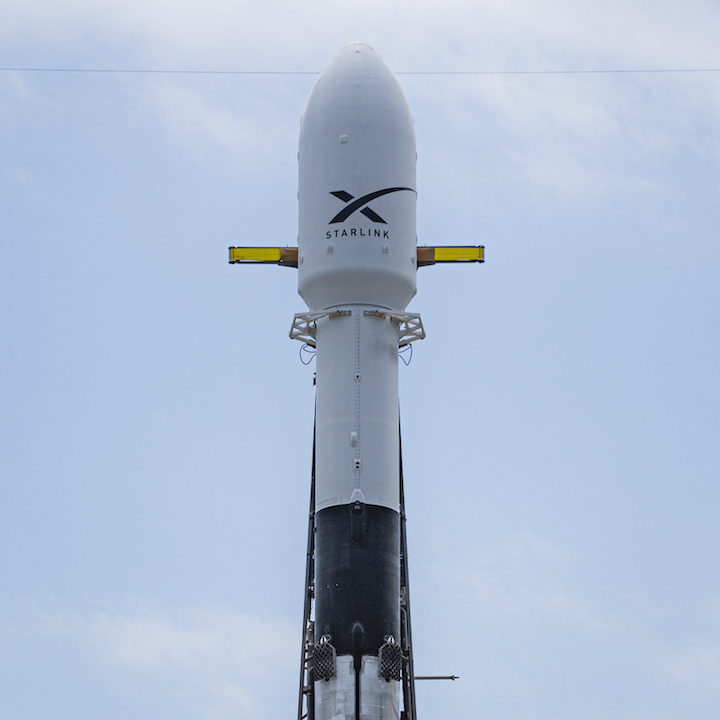
As has become customary on these missions, the Falcon 9 was transported to the pad for its Static Fire Test with the Starlink payload “stack” already in place. This is quite different to other SpaceX customers, which are installed after the Static Fire Test, following a September 2016 anomaly in which the Amos-6 communications satellite was lost in a pre-flight explosion on the pad. One of the key benefits of hauling the Falcon 9 out to the pad with the Starlink payload pre-integrated is that the Static Fire Test of the nine Merlin 1D+ first-stage engines can be conducted only a day or two prior to launch. As such, B1048 was not transported out to Pad 39A until Friday, 13 March.
Assuming an on-time liftoff on Sunday morning, this will be SpaceX’s sixth launch of 2020 and the sixth Falcon 9 mission in a row to utilize a flight-proven core stage.
Quelle: AS
-----
Update: 15.00 MEZ
.
STARLINK MISSION
On Sunday, March 15, SpaceX stood down from its launch attempt of Starlink satellites. A standard auto-abort was triggered due to out of family data during engine power check. SpaceX will announce next launch date opportunity once confirmed on the Range.
Falcon 9’s first stage supported the Iridium-7 NEXT mission in July 2018, the SAOCOM 1A mission in October 2018, the Nusantara Satu mission in February 2019, and the second launch of Starlink in November 2019. Following stage separation, SpaceX will land Falcon 9’s first stage on the “Of Course I Still Love You” droneship, which will be stationed in the Atlantic Ocean. Falcon 9’s fairing previously supported the first launch of Starlink in May 2019. Approximately 45 minutes after liftoff, SpaceX’s fairing recovery vessels, “Ms. Tree” and “Ms. Chief,” will attempt to recover the two fairing halves.
Quelle: SpaceX
+++
Delayed again: SpaceX Falcon 9 launch scrubbed upon liftoff due to engine power issue
SpaceX aborted the launch as they got down to zero on liftoff.
CAPE CANAVERAL, Fla. - After delaying the launch on Saturday, SpaceX attempted to launch its Falcon 9 rocket on Sunday morning but failed to do so after because of engine power issues.
The launch was expected to occur on Sunday at 9:22 a.m. from Kennedy Space Center but as liftoff hit zero, SpaceX aborted the mission. They stated that the abort was auto-triggered because of an engine power check.
That is the last launch attempt for the day. The date of the next attempt has not been announced yet.
The Falcon 9 rocket will take 60 Starlink satellites into space. These satellites help less developed nations have internet access.
On Friday, SpaceX completed a successful static fire test of its Falcon 9 rocket.
Quelle: FOX35
----
Update: 16.03.2020
.
SpaceX scrubs Starlink launch from Kennedy Space Center at last second
A SpaceX Falcon 9 rocket briefly fired its engines at Kennedy Space Center Sunday morning, producing a plume of smoke before computers automatically aborted the sequence and forced a scrub.
"Standing down today," SpaceX said after the 9:22 a.m. attempt at pad 39A. "Standard auto-abort triggered due to out-of-family data during engine power check."
A new launch date was not announced, but SpaceX said it would work with the Air Force to find a window.
If it had launched, this flight would have marked the company's sixth under the Starlink banner, an effort to deliver internet connectivity from low-Earth orbit. The constellation's size currently sits at 300 satellites and will push to 360 with this mission.
The Falcon booster, meanwhile, previously flew four times and was slated to target a landing on the Of Course I Still Love You drone ship in the Atlantic. SpaceX was also planning on conducting a fairing recovery attempt using ships with massive nets to "catch" them as they fall.
Over the last couple years, the use of pad 39A has not been routine for SpaceX. It's mostly reserved for crewed flights, tentatively planned for the second quarter, and three-core Falcon Heavy missions. But if the company plans on drastically increasing its cadence in the coming years, it will have to use both pad 39A and Cape Canaveral's Launch Complex 40 and regularly switch between them.
Quelle: Florida Today
----
Update: 18.03.2020
.
Starlink launch from Kennedy Space Center live:
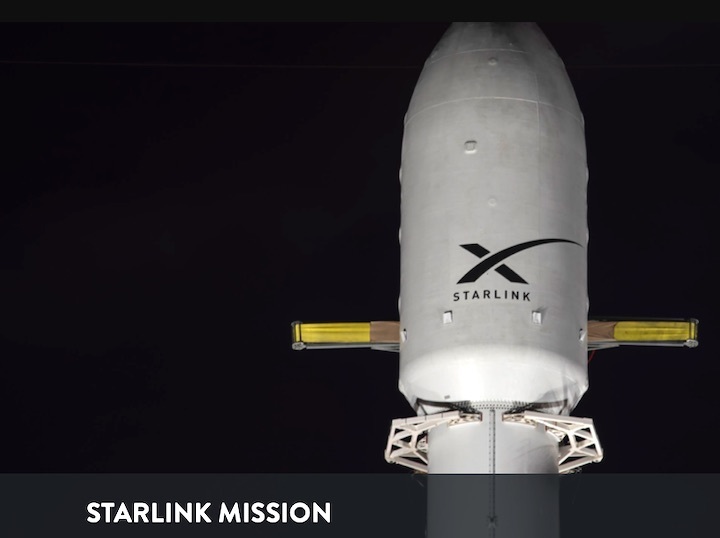
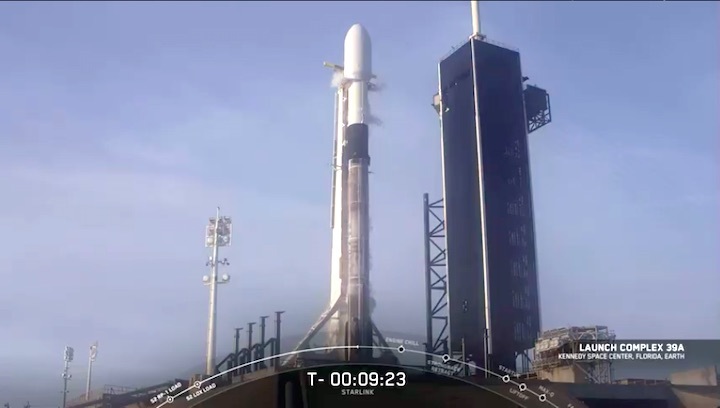
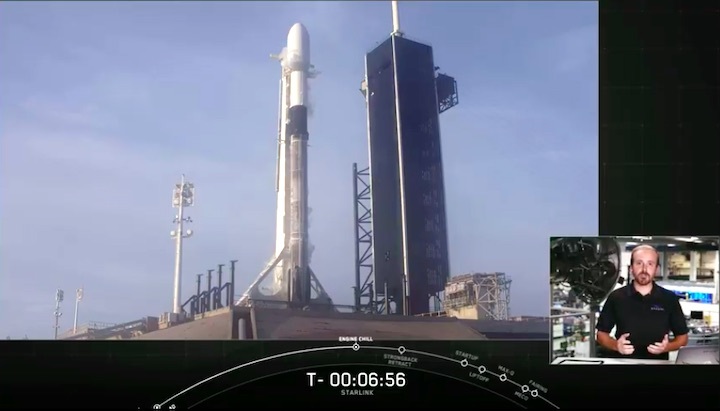
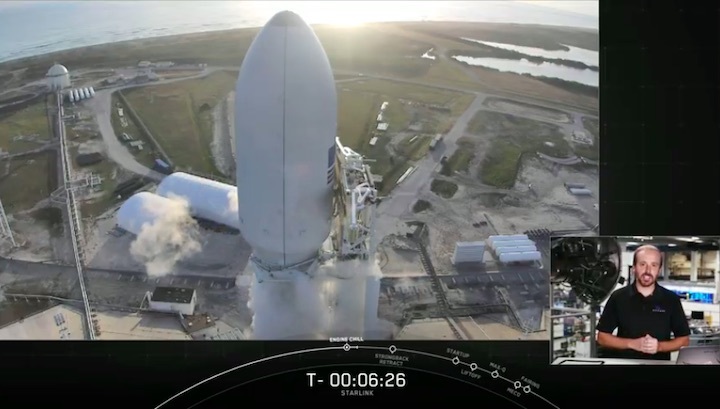
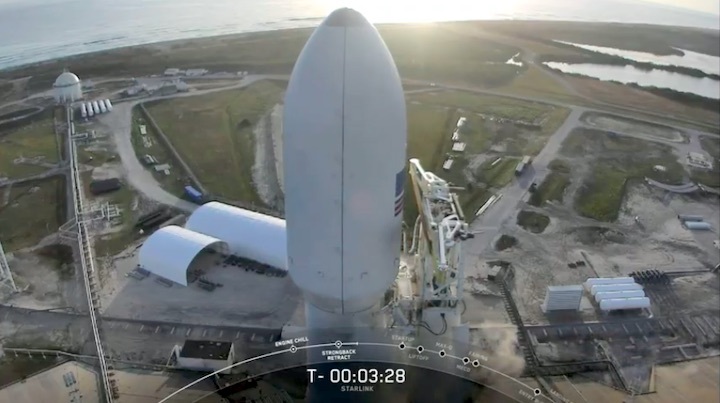
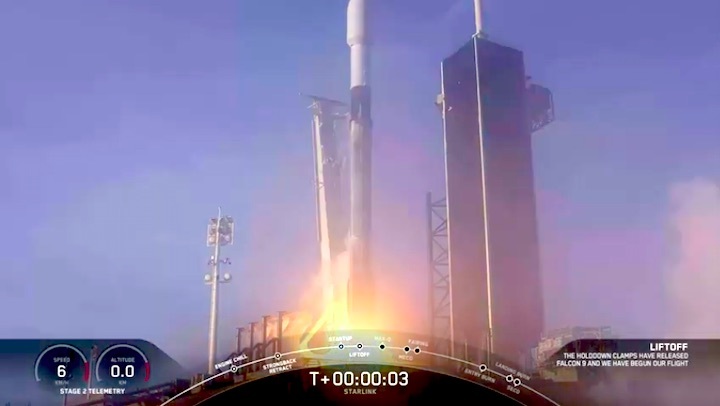
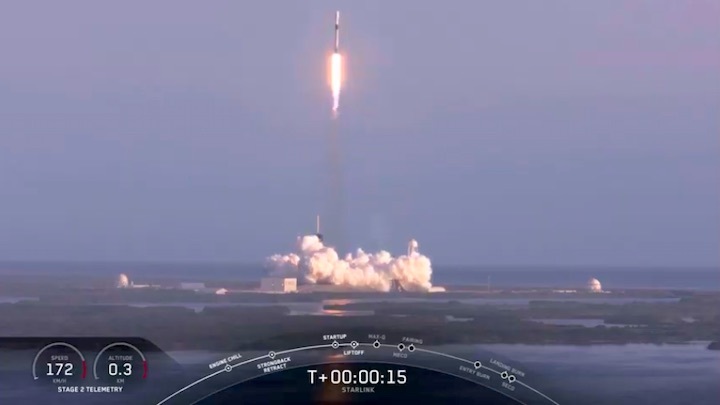
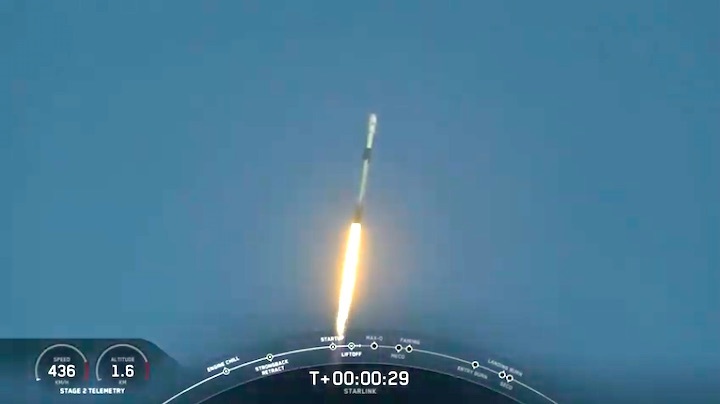
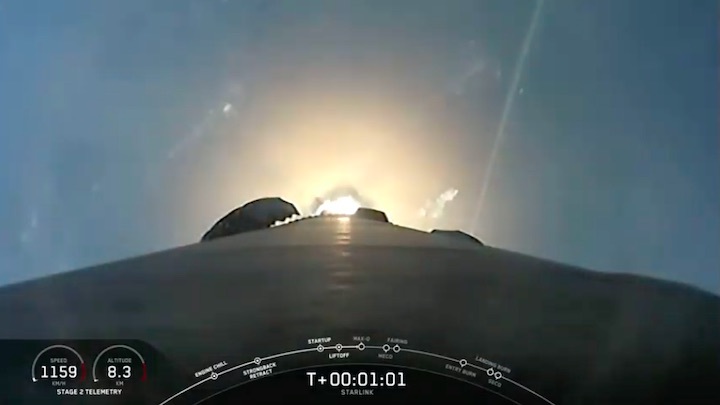
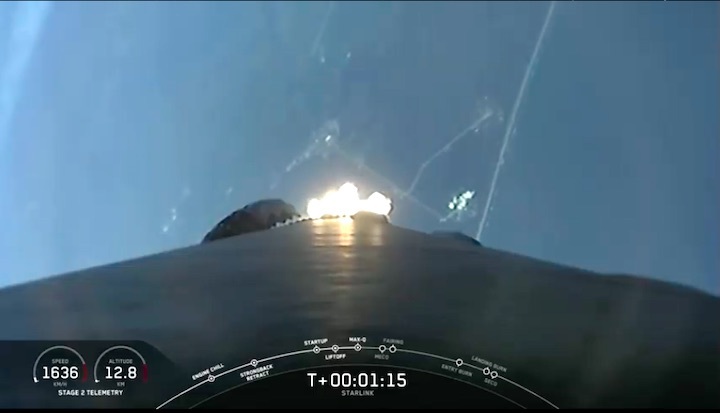
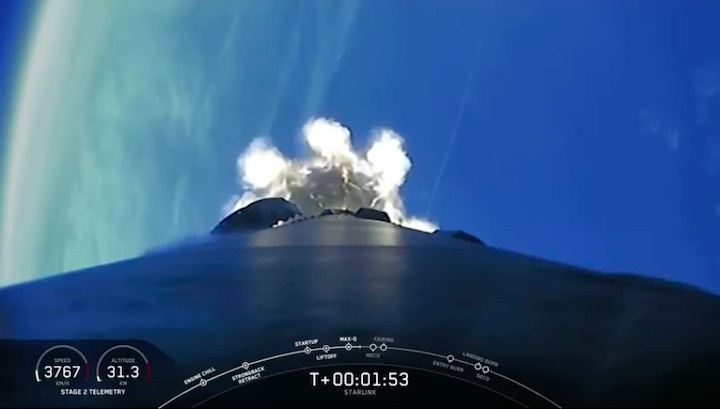
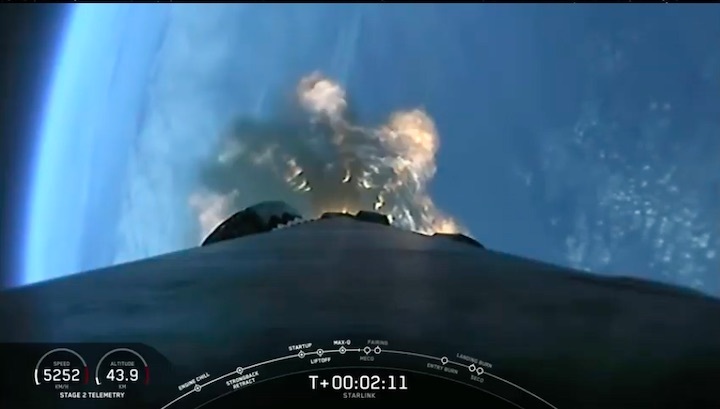
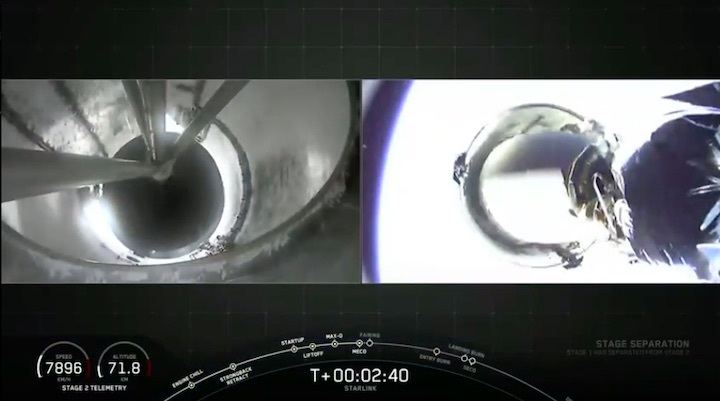







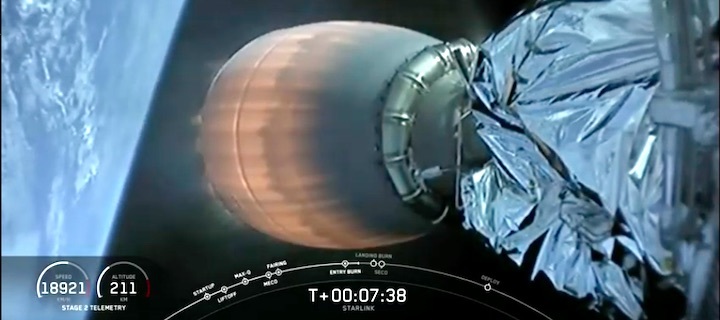
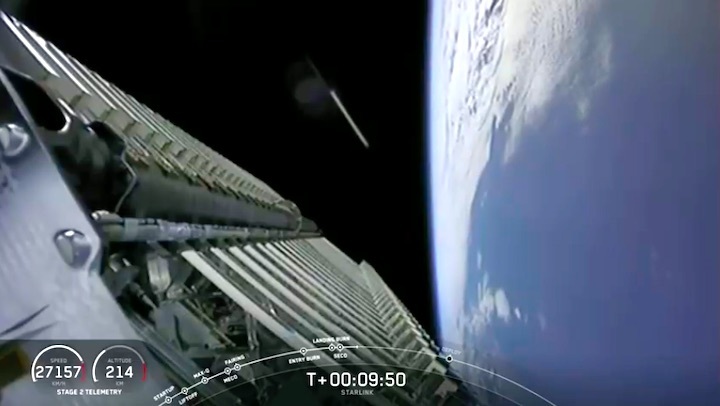
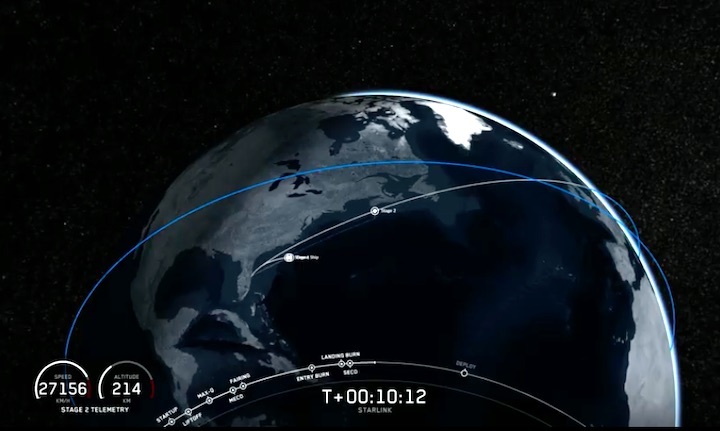
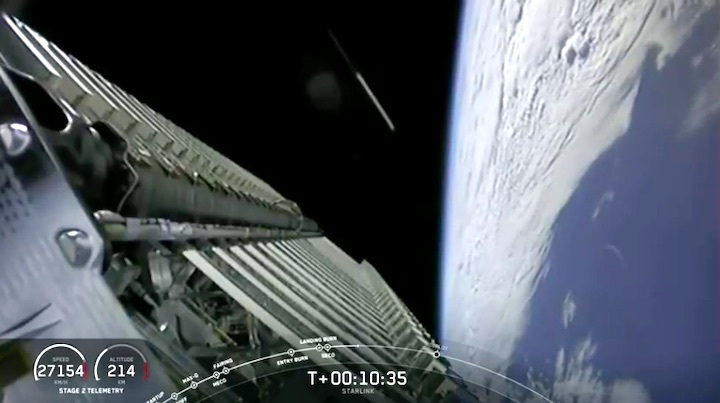
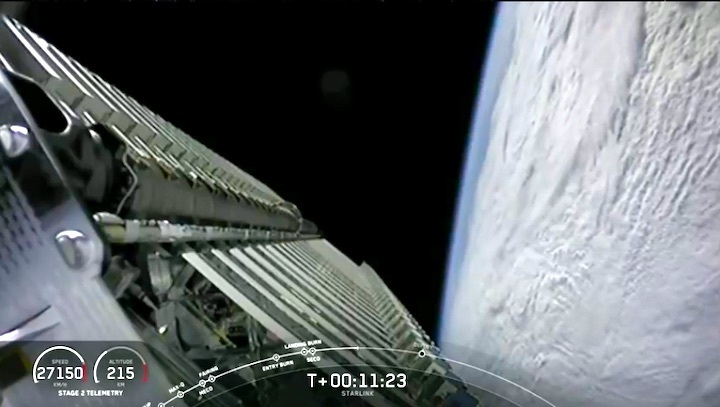
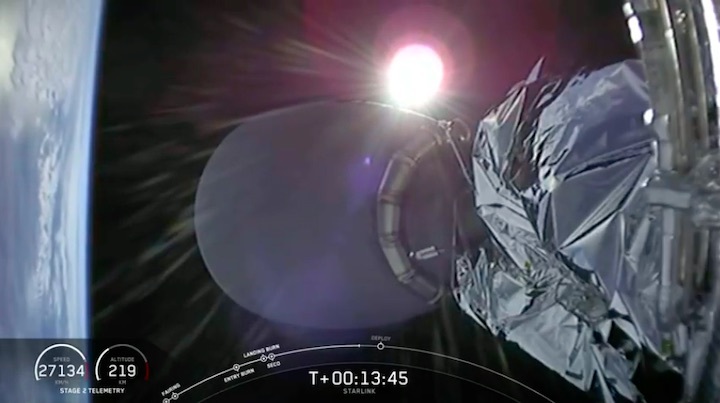
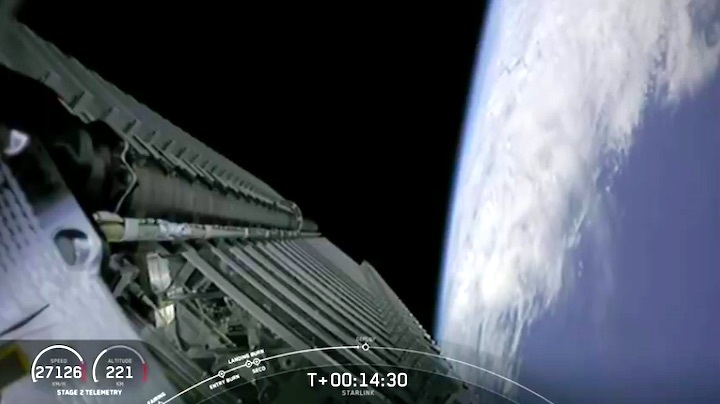
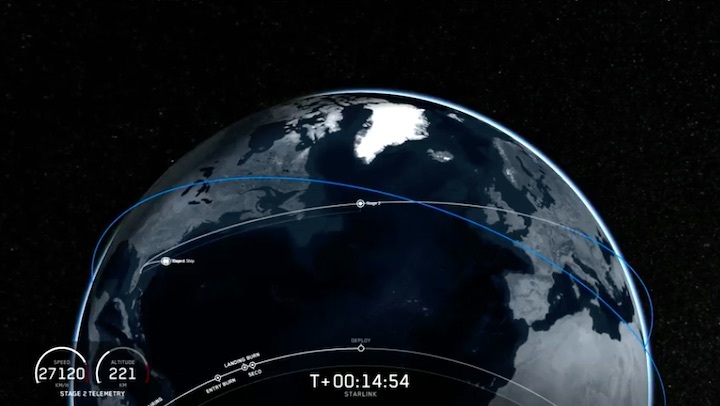
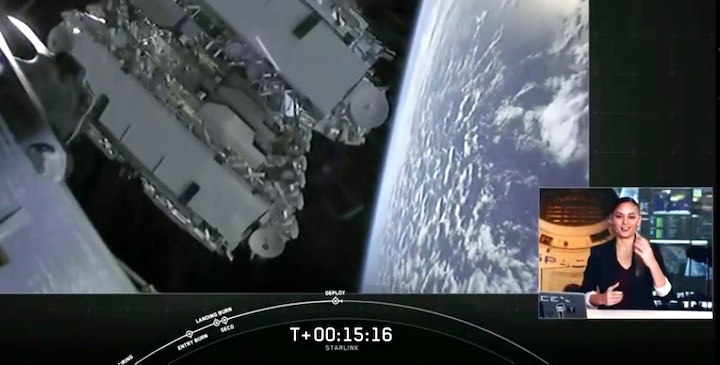
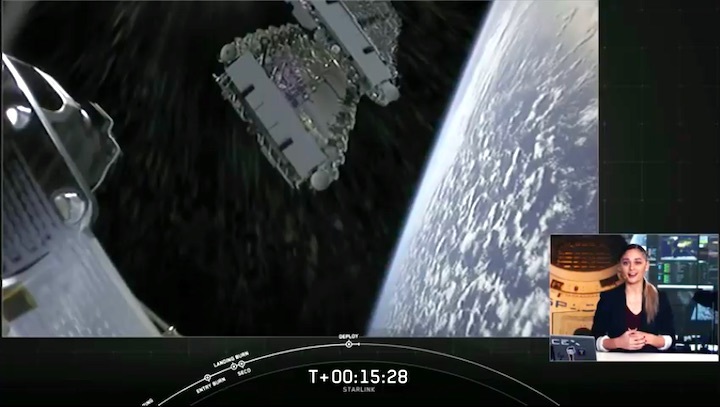
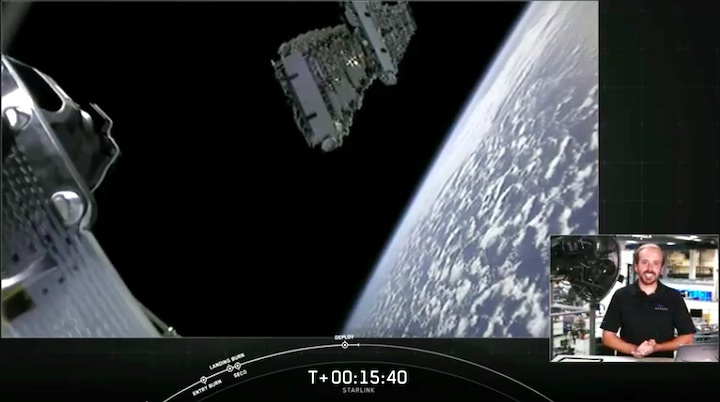
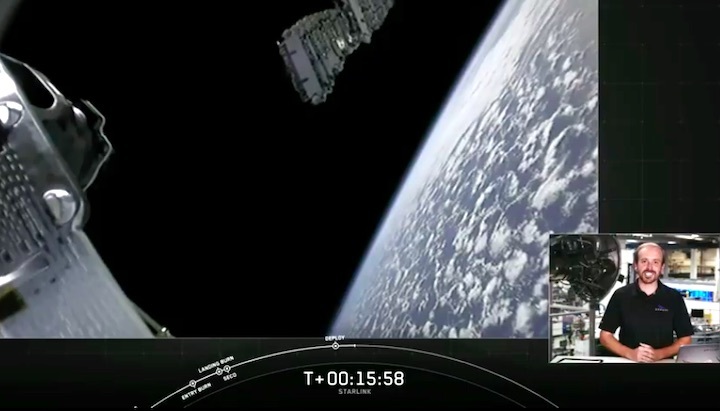
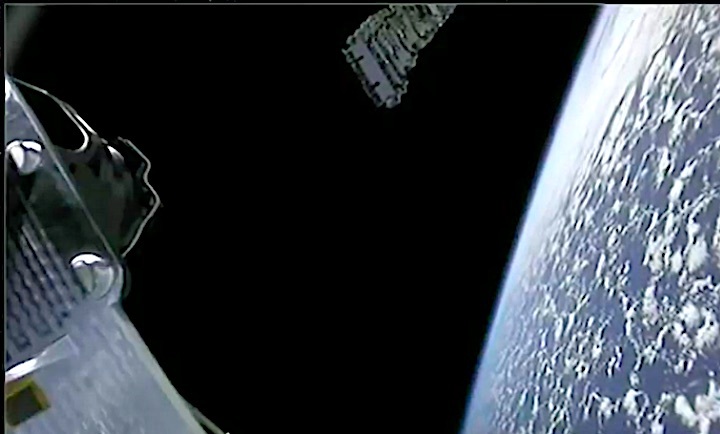
Quelle: SpaceX
